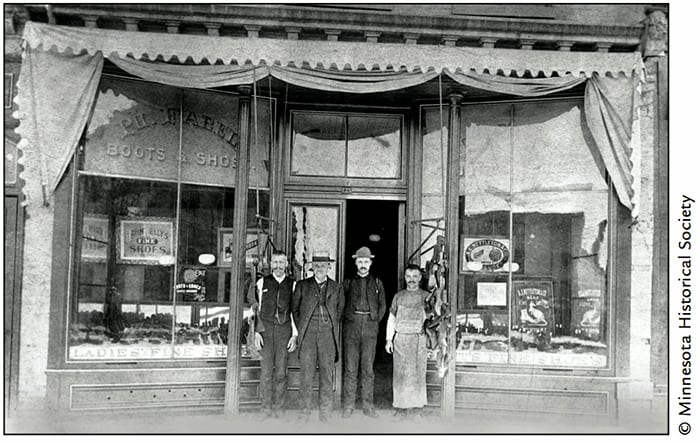
On Saturdays when I was a kid, my friends and I took the streetcar—later the bus—to downtown Saint Paul. Sometimes we went to the library, where the wise librarians knew how to help active boys find books that would hold their interest and keep them coming back for more. Almost sixty years later, I can still name some of the char- acters in John R. Tunis’s baseball fiction. Sometimes we went to the movies, choosing between the six or eight movie theaters within a few blocks of Seventh and Wabasha. Sometimes, when we had extra money from allowance or lawn mowing, we went to the library and the movies and to Bridgeman’s for a malt or sundae. The ride from our stop on Grand Avenue in front of Hervig’s Grocery seemed boring and longer than it actually was. In those days, Grand consisted mostly of drugstores, groceries, and car dealerships. But we always knew we were downtown when we saw the familiar Fabel’s Shoe Store sign facing us as we approached Seven Corners. It was right about where the Xcel Center now sits.
I’m a geezer now. While I’m not one who thinks that only the good old days were great, I am curious about my past and the past of this city that I love and can’t ever leave. I decided to find out about Fabel’s Shoes. It turns out that I went to Central High School with one of those Fabels and went to grade school and high school with the woman who married him. I found amazing pictures and documents and family history that I was able to examine and use. Following is the short form of the Fabel’s Shoes story.
Conrad Fabel emigrated to Philadelphia from Darmstadt Hessia (Germany) in 1850. In 1856 he moved to Saint Paul with his family. He was the first cobbler in the state. He and his son, Philip, opened shop on Fort Road. Among the customers for their custom-made shoes and boots were James J. Hill, Governor Alexander Ramsey, and many of the city’s elite who lived in Irvine Park. After a few years, they split up; one suspects some discord occurred. Conrad continued making and selling shoes and boots, while Philip bought and sold ready-made shoes from a factory in Phila- delphia. Father and son remained competitors within two or three blocks of each other for the balance of Conrad’s career. When Philip needed more credit to meet the growing demand for shoes, he turned to his friend and customer Governor Ramsey, who wrote a letter to the shoe factory attesting to Philip Fabel’s integrity and creditworthiness.
Philip Fabel was joined in business by his son W. E. (Walter Sr.) Fabel. Early in the twentieth century, the Fabels began to specialize. Their neighbor, the famed orthopedic surgeon Arthur Gillette, started ordering special shoes for his patients. Soon the Fabels were the provider of shoes for patients at the State Hospital for Crippled Children—known after 1926 as the Gillette Hospital for Crippled Children. One rehabbed part of that complex still stands today on the shores of Lake Phalen, at 987 Ivy Avenue East. It is home to the Minnesota Humanities Commission. The Fabels were also the providers of the special shoes worn by many of Saint Paul’s nuns.
W. E. Fabel had two sons who joined him in the business: Walter and Forest. Eventually, Walter bought out Forest’s share. Forest passed away in 1980. No one in the next generation wanted the long hours and backbreaking work of running a shoe store, so, to the customers’ dismay, Walter closed the store in 1981 after a 125-year run. (He died two weeks later.) At the closing, one customer bought ten pairs of orthopedic shoes to keep her going for a long while.
I don’t know of any other existing store in Saint Paul that’s been in business and owned by the same family for 125 years. Strauss Skates, owned by the same family that started the business in Saint Paul in 1887, is in Maplewood now. But the streetcars are coming back in the form of light rail and new family businesses owned by a new generation of immigrants are starting up all over town. Most of us geezers are loving it.